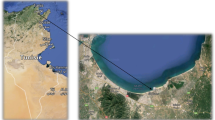Abstract
The effects of initial oil concentration and the Corexit 9500 dispersant on the rate of bioremediation of petroleum hydrocarbons were investigated with a series of ex-situ seawater samples. With initial oil concentrations of 100, 500, 1,000 and 2,000 mg/L, removal of total petroleum hydrocarbons (TPHs) with dispersant were 67.3%, 62.5%, 56.5% and 44.7%, respectively, and were 64.2%, 55.7%, 48.8% and 37.6% without dispersant. The results clearly indicate that the presence of dispersant enhanced crude oil biodegradation. Lower concentrations of crude oil demonstrated more efficient hydrocarbon removal. Based on these findings, bioremediation is not recommended for crude oil concentrations of 2,000 mg/L or higher.


Similar content being viewed by others
References
Anderson BS, Arenella-Parkerson D, Phillips BM, Tjeerdema RS, Crane D (2009) Preliminary investigation of the effects of dispersed Prudhoe Bay crude oil on developing topsmelt embryos, Atherinops affinis. Environ Pollut 157:1058–1061
APHA (2005) Standard methods for the examination of water and wastewater, 21st edn. American Public Health Association, Washington, DC
Atlas RM, Bartha R (1973) Stimulated biodegradation of oil slicks using oleophilic fertilizers. Environ Sci Technol 7:538–541
Belore RC, Trudel K, Mullin JV, Guarino A (2009) Large-scale cold water dispersant effectiveness experiments with Alaskan crude oils and Corexit 9500 and 9527 dispersants. Mar Pollut Bull 58:118–128
Da Silva AC, Oliveira FJ, Bernardes DS, Franca FP (2009) Bioremediation of marine sediments impacted by petroleum. Appl Biochem Biotechnol 153:58–66
Epstein N, Bak RPM, Rinkevich B (2000) Toxicity of third generation dispersants and dispersed Egyptian crude oil on red sea coral larvae. Mar Pollut Bull 40:497–503
Gentili AR, Cubitto MA, Ferrero M, Rodriguéz MS (2006) Bioremediation of crude oil polluted seawater by a hydrocarbon-degrading bacterial strain immobilized on chitin and chitosan flakes. Int Biodeterior Biodegrad 57:222–228
GESAMP (2007) Estimates of oil entering the marine environment from sea-based activities (IMO/FAO/UNESCO-IOC/UNIDO/WMO/IAEA/UN/UNEP Joint Group of Experts on the Scientific Aspects of Marine Environmental Protection). Rep Stud GESAMP No. 75, London
Head IM, Swannell RPJ (1999) Bioremediation of petroleum hydrocarbon contaminants in marine habitats. Curr Opin Biotechnol 10:234–239
Lindstrom JE, Braddock JF (2002) Biodegradation of petroleum hydrocarbons at low temperature in the presence of the dispersant Corexit 9500. Mar Pollut Bull 44:739–747
Mohajeri L, Aziz HA, Isa MH, Zahed MA (2010) A statistical experiment design approach for optimizing biodegradation of weathered crude oil in coastal sediments. Bioresource Technol 101:893–900
Singer MM, Aurand D, Bragin GE, Clark JR, Coelho GM, Sowby ML, Tjeerdema RS (2000) Standardization of the preparation and quantitation of water-accommodated fractions of petroleum for toxicity testing. Mar Pollut Bull 40:1007–1016
Srinivasan R, Lu Q, Sorial GA, Venosa AD, Mullin J (2007) Dispersant effectiveness of heavy fuel oils using baffled flask test. Environ Eng Sci 24:1307–1320
US-EPA (1991) Test methods for evaluating solid waste-SW 846, United States environmental protection agency. Cincinnati, Ohio
US-EPA (1999) Method 1664, revision A: N-hexane extractable material (HEM; oil and grease) and silica gel treated N-hexane extractable material (SGT-HEM; non-polar material) by extraction and gravimetry. United States Environmental Protection Agency, Cincinnati
Venosa AD, Holder EL (2007) Biodegradability of dispersed crude oil at two different temperatures. Mar Pollut Bull 54:545–553
Wang Z, Fingas M, Blenkinsopp S, Sergy G, Landriault M, Sigouin L, Foght J, Semple K, Westlake DWS (1998) Comparison of oil composition changes due to biodegradation and physical weathering in different oils. J Chromatogr A 809:89–107
Wolfe MF, Olsen HE, Gasuad KA, Tjeerdema RS, Sowby ML (1999) Induction of heat shock protein (hsp) 60 in Isochrysis galbana exposed to sublethal preparations of dispersant and Prudhoe Bay crude oil. Mar Environ Res 47:473–489
Acknowledgments
Authors would like to thank Dr. Shannon Frances for her helpful advice.
Author information
Authors and Affiliations
Corresponding author
Rights and permissions
About this article
Cite this article
Zahed, M.A., Aziz, H.A., Isa, M.H. et al. Effect of Initial Oil Concentration and Dispersant on Crude Oil Biodegradation in Contaminated Seawater. Bull Environ Contam Toxicol 84, 438–442 (2010). https://doi.org/10.1007/s00128-010-9954-7
Received:
Accepted:
Published:
Issue Date:
DOI: https://doi.org/10.1007/s00128-010-9954-7




